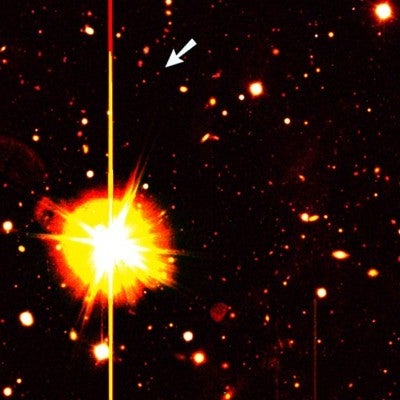Light from an explosion more than half way across the universe has been detected by an internet amateur telescope that takes images for students and teachers free of charge.
The explosion, known as a gamma-ray burst, was photographed by the Seeing in the Dark Internet Telescope (SIDINT) in New Mexico on March 30. The SIDINT digital photos show the burst flaring up briefly and then fading from view within 4 hours.
Funded by the National Science Foundation, SIDINT is part of the public outreach effort associated with science writer Timothy Ferris’s documentary film Seeing in the Dark. The telescope has taken thousands of images for students and teachers who visit the show’s web site. The film, which premiered last year, is scheduled for rebroadcast on PBS at 8 P.M. Wednesday, June 11, 2008 (check local listings).
Astronomers studying the gamma-ray burst determined that its light traveled 8.4 billion light-years — more than half way across the radius of the observable universe — before reaching Earth. The light therefore was older than the Sun and Earth, which formed some 4.5 billion years ago.
“This detection of ancient light demonstrates that amateur astronomers with backyard telescopes can make real contributions to science, observing celestial events that were beyond the reach of even the largest professional telescopes within living memory,” says Ferris, whose film celebrates amateur astronomy. One of the stargazers appearing in the film, the rock musician Michael Koppelman, photographed an even more remote gamma-ray burst from his homemade observatory in rural Minnesota in 2006.
Gamma-ray bursts are the most energetic events in the known universe. Astronomers remain uncertain about just how they are created, but one mechanism may be the collapse of a giant star to form a black hole, resulting in a titanic explosion that can spit out intense jets of gamma rays, X-rays, and visible light.
When NASA’s orbiting SWIFT satellite detected the March 30 gamma-ray burst, it automatically emails the celestial coordinates to professional and amateur astronomers around the world. In Tucson, Arizona, SIDINT telescope manager Adam Block responded quickly to the news, activating the telescope over the internet and obtaining a sequence of images within minutes of the SWIFT alert. The resulting light curve data can be employed by astrophysicists to help understand how the bursts are produced. See a video of Block’s SIDINT images here.
The March 30 gamma-ray burst was also imaged by professional astronomers at observatories in France, Chile, Sweden, England, Arizona, Texas, and by the orbiting Japanese Hinode X-Ray Telescope. But the SIDINT images are the sole amateur contributions posted to date.
Viewers of the film Seeing in the Dark see SIDINT being installed by a team of four specialists in under 3 hours. The telescope consists entirely of commercially available, off-the-shelf components, but its computer-controlled mount and sensitive digital camera give it a range exceeding that of the famous Hale reflector at Palomar a half century ago, then the world’s largest telescope. Students using SIDINT are able to photograph galaxies more than 100 million light-years from Earth.










